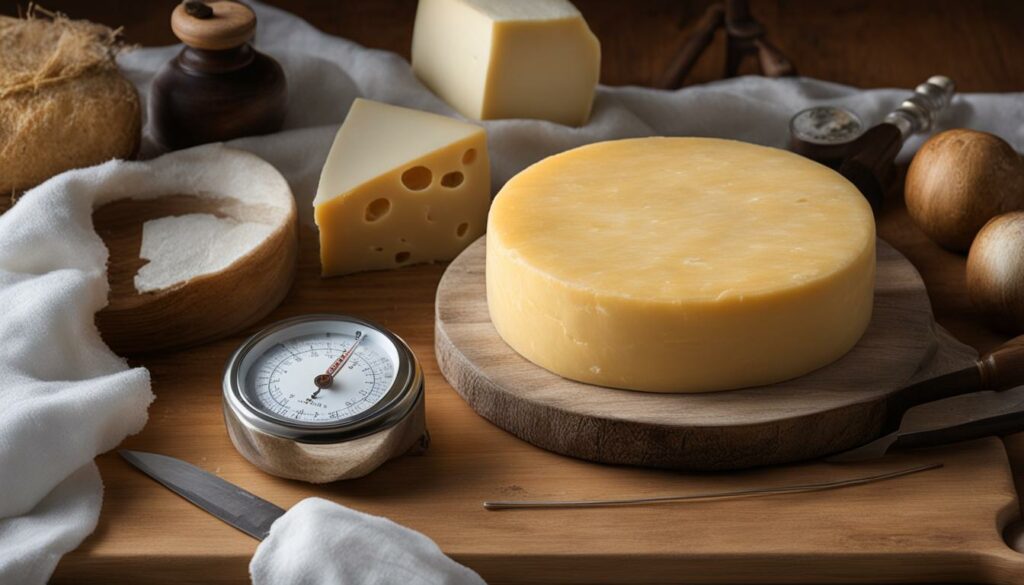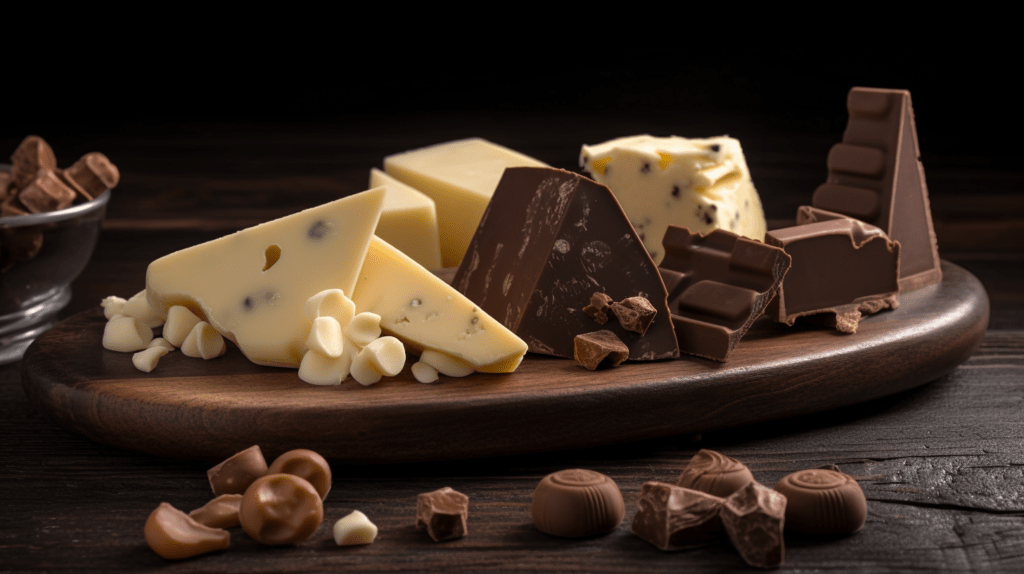Are you a cheese enthusiast looking to explore new flavors? If so, you’re in for a treat! Allow us to introduce you to Caerphilly Cheese, a true gem in the world of Welsh cheese. This artisanal and traditional cheese is sure to captivate your taste buds with its unique characteristics and rich history.
When it comes to cheese, Caerphilly is truly a standout. This savory delight is known for its salty, moist, and slightly tangy flavor, with a hint of refreshing lemon. Its light and soft texture, paired with its crumbly center, makes each bite an irresistible delight.
Caerphilly Cheese has a fascinating history. Initially popular among miners in the 19th century, its production faced challenges with the expansion of railway networks. However, it was revived by cheddar makers in Somerset who recognized its potential as a quick-return product. Today, authentic producers like the Duckett family and Gorwydd Caerphilly keep the tradition alive.
The cheese-making process of Caerphilly Cheese is a testament to the craftsmanship and dedication of artisan cheese makers. Each step, from the morning milking to the pressing of the cheese, is executed with precision to ensure the highest quality product.
Aside from its fascinating history and exquisite flavor, Caerphilly Cheese offers endless possibilities when it comes to pairing. Enjoy it on its own, savoring each flavorful bite, or explore a variety of recipes that incorporate this versatile cheese. Its mild and tangy taste perfectly complements fruits, such as apples and pears. When paired with hoppy craft ales or accompanied by crusty sourdough bread, Caerphilly Cheese takes your culinary experience to new heights.
So, why wait? Embrace the taste of Wales and discover the delightful flavors of Caerphilly Cheese today. Whether you’re a cheese connoisseur or a curious foodie, this Welsh cheese is guaranteed to impress.
The Rich History of Caerphilly Cheese
Caerphilly cheese holds a significant place in the history of Welsh cheese. It gained popularity among miners in the 19th century for its distinctive flavor and was widely enjoyed throughout Wales. However, as railway networks expanded, and milk became more accessible from distant areas, the demand for Caerphilly cheese declined.
Interestingly, cheddar makers in Somerset recognized the potential of Caerphilly cheese as a quick-return product. Some dairies began producing both cheddar and Caerphilly cheese to meet the demand of the market. This dual production helped sustain the popularity of Caerphilly cheese during those challenging times.
During World War 2, the dairy industry underwent central control, and soft cheeses like Caerphilly were unfortunately banned. This setback proved to be devastating for many Caerphilly producers, and they were unable to recover from the hardships. However, despite the difficulties, the Duckett family of Wedmore remained committed to producing Caerphilly cheese and became one of the few authentic producers that endured.
“The history of Caerphilly cheese is a testament to its resilience and the dedication of those who appreciate its unique qualities.”
Caerphilly cheese began to see a resurgence in popularity when the movement to preserve and celebrate Britain’s great cheeses gained momentum. Artisan producers like the Duckett family and Gorwydd Caerphilly continued to produce this beloved Welsh cheese, showcasing its rich heritage and enticing flavors.
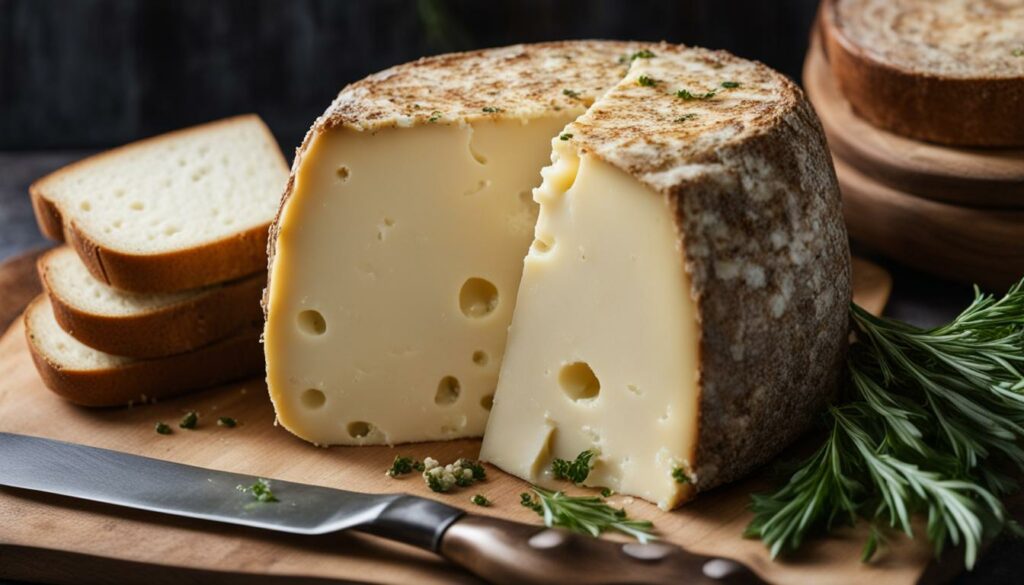
The Cheese-Making Process of Caerphilly Cheese
Creating Caerphilly cheese is a meticulous process that involves several essential steps. Artisan cheese makers take great care and attention to detail throughout the production, resulting in the exceptional quality and flavor that Caerphilly cheese is known for.
- Morning Milking: The cheese-making process begins early in the morning with the milking of the cows. The milk is carefully collected and warmed to prepare it for the next step.
- Starter Addition: Once the milk is warmed, the starter is added. This starter helps initiate the fermentation process that gives Caerphilly cheese its unique taste and texture.
- Rennet and Curd Formation: After ripening, rennet is added to the milk to form the curd. The curd is then cut and stirred continuously until it reaches the desired acidity level.
- Transfer and Cooling: The curds and whey are transferred to a cooling table, allowing the whey to drain off. This helps further separate the curds, creating the distinct texture of Caerphilly cheese.
- Texturing and Salting: The curds are then textured by hand, giving them their characteristic shape and structure. They are mixed with salt, enhancing the flavor and preserving the cheese.
- Molding and Pressing: The textured curds are carefully filled into molds, creating the final shape of the cheese. The filled molds are then pressed to remove any remaining whey and encourage proper aging.
In each step of the cheese-making process, the artisan cheese makers’ expertise shines through, ensuring the highest quality Caerphilly cheese for cheese enthusiasts to enjoy.
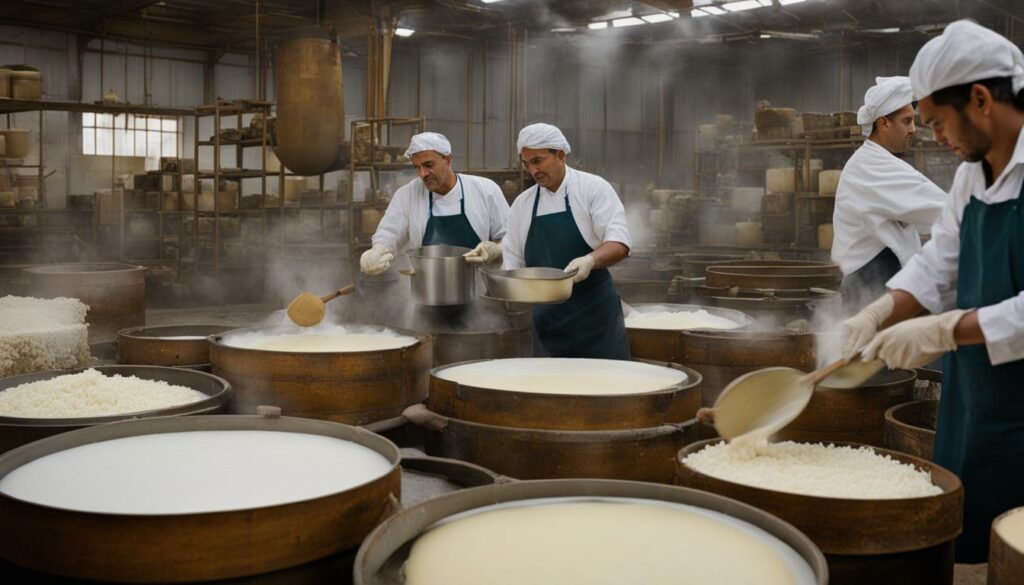
| Steps | Description |
|---|---|
| Morning Milking | The cows are milked early in the morning to obtain fresh milk. |
| Starter Addition | The warmed milk is inoculated with a starter that aids in fermentation. |
| Rennet and Curd Formation | Rennet is added to form the curd, which is then cut and stirred. |
| Transfer and Cooling | The curds are transferred to a cooling table to separate them from the whey. |
| Texturing and Salting | The curds are textured by hand and mixed with salt for taste and preservation. |
| Molding and Pressing | The curds are filled into molds and pressed to remove excess whey. |
The Unique Flavor of Caerphilly Cheese
Caerphilly cheese is known for its unique flavor profile. It is salty, savory, and slightly tangy, with a hint of lemony freshness. The rind of the cheese has a mushroomy flavor, while the creamy breakdown below offers a rich and creamy taste. The center has a lactic, lemony, and crumbly texture. These three characteristics combine to create a depth of flavor that is distinctively Caerphilly.
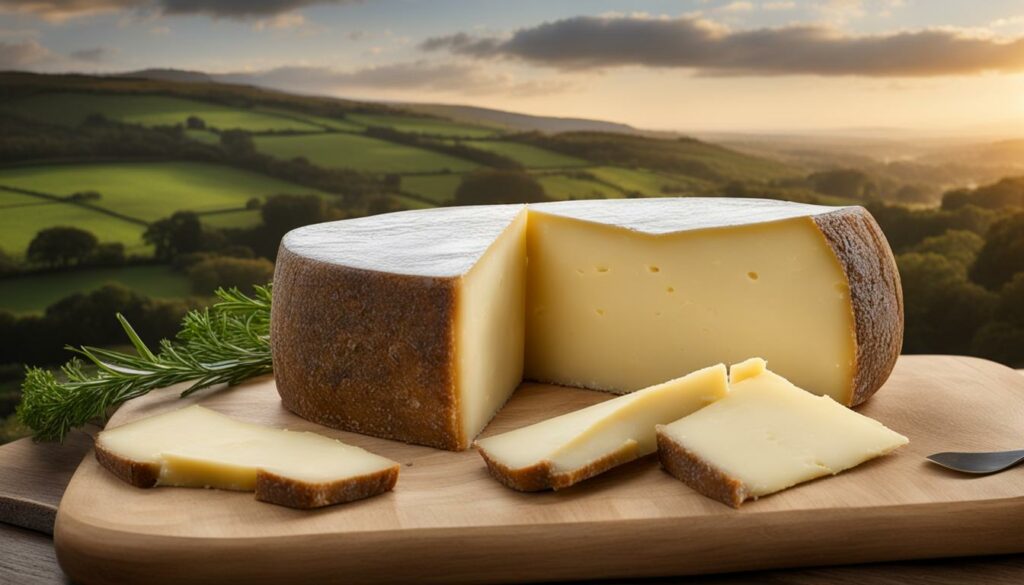
Caerphilly cheese’s savory, tangy, and crumbly qualities make it a delightful option for cheese connoisseurs. The tanginess adds a vibrant kick to the overall flavor, while the crumbly texture provides a satisfying mouthfeel. The subtle lemony notes bring a refreshing element to the cheese, complementing the savory and mushroomy undertones.
Whether enjoyed on its own or incorporated into various dishes, Caerphilly cheese brings a unique and sophisticated flavor profile to any culinary creation. Its versatility allows it to shine in both sweet and savory recipes, adding a tangy and creamy dimension to dishes. From gourmet sandwiches to cheese boards, Caerphilly cheese is a versatile ingredient that is guaranteed to elevate any culinary experience.
| Flavor Profile of Caerphilly Cheese | |
|---|---|
| Savory | ✔ |
| Tangy | ✔ |
| Crumbly | ✔ |
| Mushroomy | ✔ |
| Creamy | ✔ |
| Lemony | ✔ |
Cheese Pairing Options with Caerphilly Cheese
Caerphilly cheese is a versatile cheese that pairs well with various flavors. Whether you’re enjoying it on its own or incorporating it into recipes, Caerphilly cheese offers a delightful addition to any meal.
Welsh Rarebit
One popular way to enjoy Caerphilly cheese is by making Welsh Rarebit. This classic dish involves melting Caerphilly cheese and spreading it over toast. The creamy, tangy flavor of the cheese perfectly complements the toasty bread, creating a comforting and delicious combination.
Fruit Pairings
Caerphilly cheese also pairs well with a variety of fruits. The creamy and slightly tangy nature of the cheese adds a lovely contrast to the sweetness of fruits like apples and pears. The combination of flavors creates a balance that is both refreshing and satisfying.
Craft Ales and Sourdough Bread
If you’re a fan of craft ales, Caerphilly cheese is a fantastic choice for pairing. Its mild and lactic flavor enhances the hoppy and citrusy notes of the beer, creating a harmonious taste experience. Enjoy the cheese alongside some crusty sourdough bread for a complete and satisfying combination.
Whether you’re planning a cheese board or a charcuterie platter, be sure to include Caerphilly cheese. Its unique flavor and versatility make it a great addition to any gathering. Experiment with different pairings and discover the wonderful taste combinations that Caerphilly cheese has to offer.
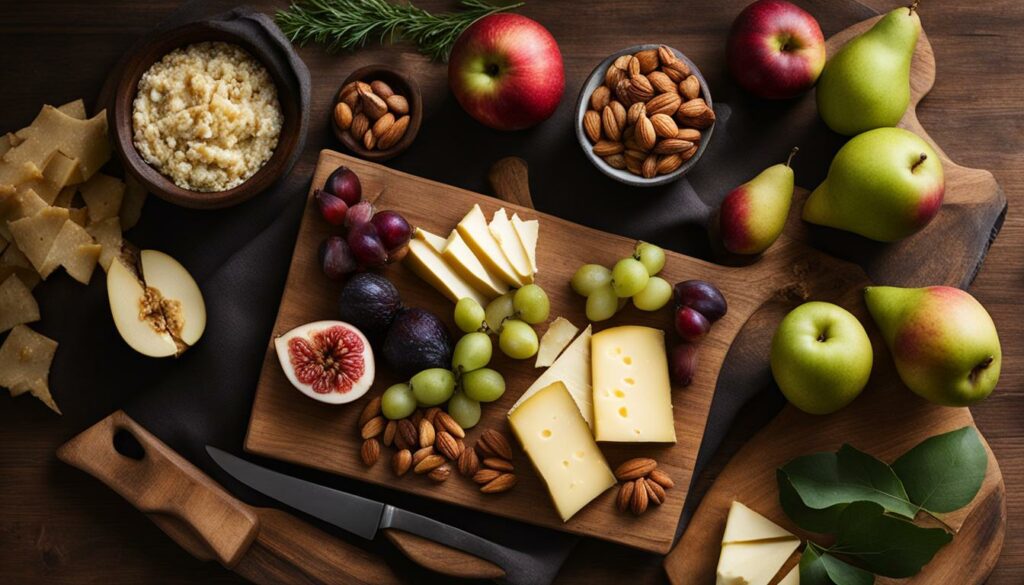
Conclusion
Caerphilly cheese is a beloved Welsh cheese with a rich history and unique flavor. Despite the challenges it has faced over the years, authentic producers like the Duckett family and Gorwydd continue to create this artisan cheese, keeping its tradition alive. Whether enjoyed on its own or used in various recipes, Caerphilly cheese adds a delightful taste to any dish.
The versatility of Caerphilly cheese makes it a fantastic addition to any cheese pairing or cheese board. Its distinct flavor profile, combining saltiness, savory notes, and a touch of tanginess with a hint of lemon, offers a truly unique taste. The creamy breakdown and crumbly texture add depth, while the rind provides a delightful mushroomy flavor. Embrace the taste of Wales and savor the delightful flavors of Caerphilly cheese today.
So, why wait? Explore the world of Caerphilly cheese and indulge in its exquisite flavors. Whether you’re enjoying it with a glass of hoppy craft ale, pairing it with fruits and crusty bread, or simply savoring its creamy goodness on its own, Caerphilly cheese is sure to please your taste buds. Experience the authentic taste of Wales by trying Caerphilly cheese today and elevate your cheese experience with its unique and delightful flavors.
FAQ
What is Caerphilly cheese?
Caerphilly cheese is a traditional Welsh cheese known for its salty, moist, and savory flavor with a hint of lemon. It has a light, soft texture and is typically young, usually only a few months old. Caerphilly cheese may or may not have a rind.
What is the history of Caerphilly cheese?
Caerphilly cheese was popular among miners in the 19th century but declined with the expansion of railway networks and the availability of milk from further afield. However, it saw a resurgence when cheddar makers in Somerset began producing it as a quick-return product. The Duckett family of Wedmore in Somerset has been making Caerphilly cheese since the 1920s. Today, it is still produced by them and other authentic producers like Gorwydd Caerphilly.
How is Caerphilly cheese made?
The process of making Caerphilly cheese involves several steps. The milk is warmed, the starter is added, and after ripening, rennet is added to form the curd. The curd is cut and stirred until it reaches the desired acidity. The curds and whey are then transferred to a cooling table, and the whey is drained off. The curds are textured by hand, mixed with salt, and filled into molds. The filled molds are then pressed.
What makes Caerphilly cheese unique in flavor?
Caerphilly cheese has a unique flavor profile. It is salty, savory, and slightly tangy, with a hint of lemony freshness. The rind has a mushroomy flavor, while the creamy breakdown below offers a rich and creamy taste. The center has a lactic, lemony, and crumbly texture. These characteristics combine to create a depth of flavor that is distinctively Caerphilly.
What are some cheese pairing options with Caerphilly cheese?
Caerphilly cheese pairs well with various flavors. It can be enjoyed on its own or used in recipes like Welsh Rarebit, where melted Caerphilly cheese is spread over toast. It also complements fruits like apples and pears, adding a creamy and tangy element to the sweetness. It pairs well with hoppy and citrusy craft ales, as well as crusty sourdough bread. Additionally, Caerphilly cheese is a great addition to any cheese board or charcuterie platter.





